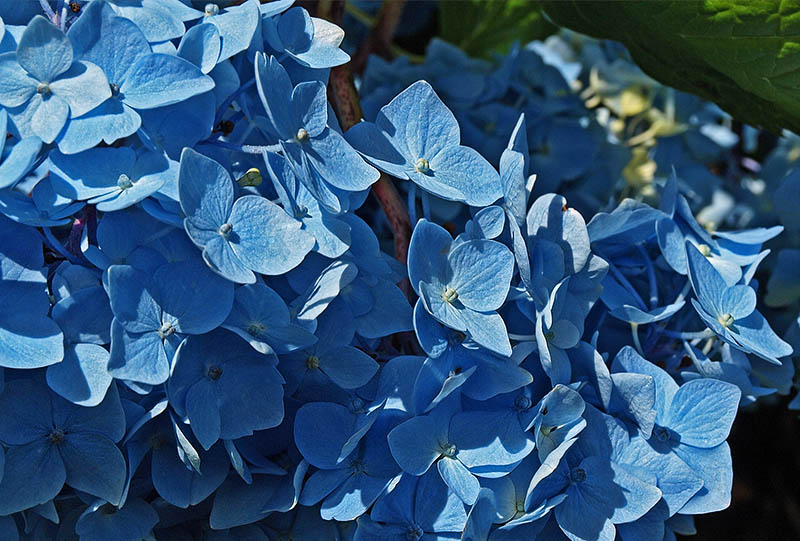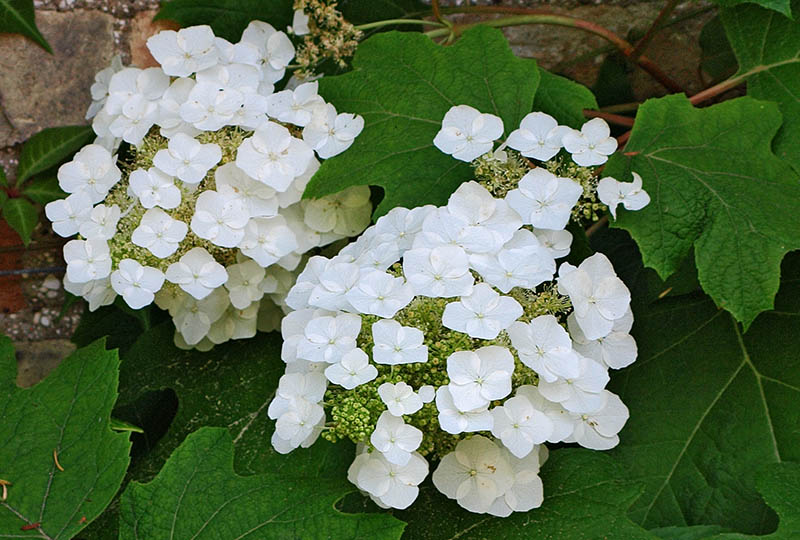Hydrangeas make me wish that I could just wave a magic wand and change my garden soil…moister and more acidic would do fine.
Then I would be able to grow blue hydrangeas, or, failing that, a nice purply-blue shade like the hydrangea in our old garden in Scotland. It was Hydrangea macrophylla ‘Mariesii’ (a lacecap) and had flowers that ranged from a good blue to a more lilac/pink shade. Many of the flowers graduated from blue at the centre of the petal to pretty much pink at the outside. It was really delightful and lovely to photograph.
The hydrangea in the top photograph is growing here in our Suffolk garden. It’s very pretty but there’s no chance of any blue in its flowers. Unlike our Scottish garden, which had a fairly acidic soil, the soil here is alkaline. So our hydrangeas will never be blue. (Oh we could try…with acid-based compost, rainwater, and added aluminium sulphate or organic materials such as coffee grounds and eggshells, but that’s doing things the hard way. Much better to go with the conditions you have.)

So I can only dream about having hydrangeas with flowers in wonderful shades of purple and blue like in the photo above. Or even a stunning blue like the hydrangea below. (Well, winter is a good time for indulging in fantasy gardening, sitting by a warm fire with your favourite books and seed catalogues.)
Visiting other people’s gardens does at least give me a chance to photograph hydrangeas of different types and colours. Finding a plant that you really love is one of the great joys of garden-visiting. And usually means that there’s a growing wishlist of plants to hunt for in the nurseries and garden centres.

I find that the flowers of the lacecap hydrangeas are much easier to photograph than the mophead types. The mopheads can be an unruly mass of flowers that don’t cooperate when it comes to creating structure within the photograph. The arrangement of the lacecaps, with their tiny ‘true’ flowers at the centre of a ring of bigger sterile flowers, means that it is easy to find an attractive angle for a photograph.
As well as the pink lacecap, we have the climbing Hydrangea petiolaris here. It’s growing along a shady fence and I’m a bit worried that it might actually be holding the fence up now! Replacing the fence panels in the future, without damaging the plant, might be really difficult, so I should try propagating some cuttings as insurance. The flowers of this climber are very like the lacecap flowers – again they make a good photograph. (I have just photographed a frost-covered flower that had lingered on the plant. That’s for another ‘frosty flowers’ blog post very soon.)

Looking at the colours of the flowers here has me dreaming of summer gardens and making plans for my own. Our soil here is rather too dry for hydrangeas to be happy. The plants we already have needed to be watered frequently while they were young and the pink lacecap can still wilt a bit on a really hot day. It may be possible to create a more suitable space for hydrangeas in one of the areas that we’re re-developing in the garden. Somewhere with a bit of shade, maybe. But there will need to be lots and lots of good compost added to the ground to help it retain moisture…that will not be a quick job!
While I work to improve the soil in the garden here, I may just have to wait before planting any more hydrangeas. Meanwhile I hope I’ll be able to enjoy more of them in the gardens I visit. It’s exciting to see plants that I’ve not seen before, such as the oakleaf hydrangea below. (These seem to be less common than the mopheads and lacecaps here in the UK.) And I hope I’ll be able to take some more photographs too. (That’s my kind of plant-hunting!)


[…] Mackay from Suffolk UK published a colourful and informative hydrangea post only a couple of hours ago and it prompted me to get mine published! I really enjoyed your post Ann […]
LikeLiked by 1 person
Cool! I’m off to read your post… 🙂
LikeLiked by 1 person
Our garden too is rather dry for lots of Hydrangeas, but we do have H. petiolaris and H. aborescens ‘Annabel’ which are both beautiful. Like you, I really enjoy Hydrangeas in other people’s more suitable gardens.
LikeLiked by 1 person
I’m hopeful that I might be able to create a better site for hydrangeas, but it will take lots of work. It would be worth it because they can make such lovely photographs. (Seeing them in other people’s gardens is another great excuse for a spot of garden-visiting, hehe!)
LikeLike
OOOO I love hydrangeas! The white oak leaf ones are very common here. My neighbor has given me some on several occasions but I haven’t had any luck with them. Once my dog pulled out a young one and went running around the yard with it : 0. She not any help with gardening!
LikeLiked by 1 person
Naughty dog, LOL! I hope you have better luck in future. 🙂 The mopheads and lacecaps are the most common here and do well in the damper areas of the country. I’m wondering if I create a bit of bog garden would that suit one…worth a try…
LikeLike
That’s one of my favourite Flowers – especially in Blue!
LikeLiked by 1 person
The blue ones are beautiful – makes me wish for acid soil!
LikeLiked by 1 person
Ann, I love all the details about hydrangeas in this post, as well as the different pictures of them! I know very little about flowers and gardening, and I learn so much from my gardening blog friends.
LikeLiked by 1 person
Thanks Shelly! I’m glad you enjoyed it and found it informative. I learn a lot from my gardening friends too! 🙂
LikeLiked by 1 person
I am looking forward to starting a garden again!
LikeLiked by 1 person
That’s great – gardening is so satisfying and immensely relaxing too. Hope it goes well!
LikeLike
Hi Ann! Loved the post on Hydrangea – both the blue and pink seem to grew well in Virginia where I used to live. I find most of them turn out be rather huge though. You must have a good sized yard to grow all the things you show. Wish I did.
LikeLiked by 1 person
Thanks Syd, I’m glad you liked it. Hydrangeas can grow pretty big over here too, but mine haven’t – probably too dry! I wish all the pictures on the blog were from my own garden. Many are (or are from our old garden in Scotland) but lots – like the lovely blue hydrangeas – were taken in gardens I’ve visited. One of my friends has a huge and beautiful garden – I’m looking forward to taking photos there this year! 🙂
LikeLiked by 1 person
A neighbour here has a whole row of blue and purple hydrangea like in your second picture, and another has a couple of bushes in her front garden, we must have acid soil (I just thought it was muddy and claggy)The flowers go an interesting sepia/off blue, faded antiquey shade when they are dying off.
LikeLiked by 1 person
Oooh, I’m trying not to be jealous! They would be wonderful for photography, especially as they fade so beautifully!
LikeLiked by 1 person
The hydrangeas are just beautiful! Such vivid colors and beautiful photography!
LikeLiked by 1 person
Thank you! I’m very glad that you enjoyed the photos and yes, hydrangeas are wonderful plants. 🙂
LikeLiked by 1 person